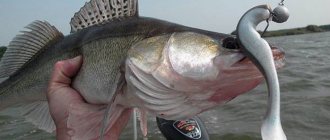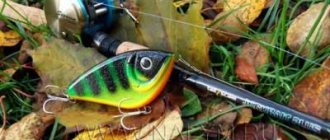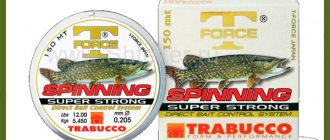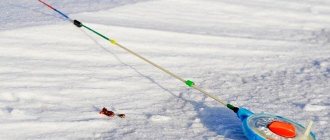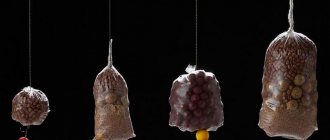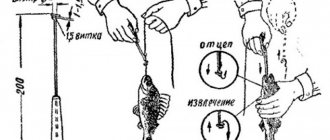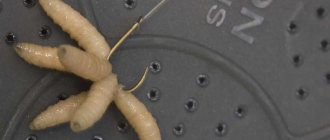Lures
For winter fishing, various types of baits, both artificial and natural, are used. Let's look at the most popular:
Jigs
They are one of the most popular baits. They are suitable for both catching peaceful fish and catching predators. Jigs are made from different materials: lead, tungsten or other non-ferrous metal. You can choose the color and size of the bait to suit you, taking into account the type of fish you want to catch.
Weight also ranges from one to five grams. Jigs are suitable for fishing both with and without baits (if a reelless one is used). The main attachment used on a jig is a bloodworm; it is excellent for winter fishing.
Spoon
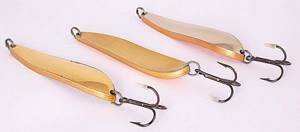
Spoons are great for catching predators in the winter, and they are especially popular. Traditionally, in winter, predatory fish species caught are pike, taimen, perch, and pike perch. Winter spinners differ from summer ones in their structure.
Typically this is a plate that is made of metal and secured with hooks. The shape and size of the spoons differ; you need to select them in accordance with the size and nature of the fish you are catching.
Balancers
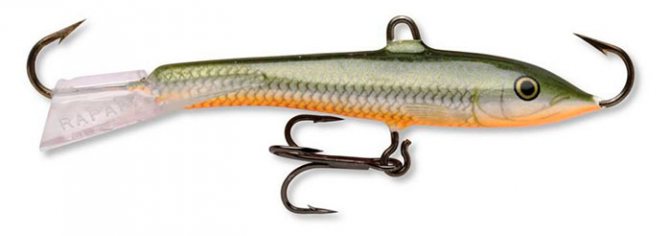
This bait is relatively new on the fishing market. Its main task is fishing from under the ice. Such baits are used for vertical fishing. The balancer resembles the shape of a fry. The fishing line is attached through a loop, which is located on the back, and strong single hooks are located closer to the tail and nose.
If large and medium models are used, then another hook is attached to the bottom, which is already triple. At the end of the balancer there must be a plastic tip, which will correct the behavior of the balancer.
Maggot
This fly larva is an excellent replacement for bloodworms, and in some cases it may be better. The bait stays firmly on the hook and attracts large fish.
You can catch a variety of fish with maggots: perch, crucian carp, and bream. You need to store the bait in the refrigerator, without thinking about the expiration date.
Dragonfly larva
Quite an unusual bait, but it is quite a tasty morsel for many species of fish. It is quite large in size and holds firmly on the hook. Serves as bait for many fish that are able to eat it. The larvae are harvested in the fall, and they are found near swampy areas of water that are overgrown with cattails or telores. Larvae are stored in grass at a temperature of 2 to 4 degrees.
Feeder for fishing from a boat
An experienced fisherman knows that you should not go out to catch large fish without a special feeder, since not every feeder is designed for catching fish in fast-flowing river conditions. Making a device is not complete without a pair of fasteners, a drill, a tube, a lock, a loop, lead, a rivet and a rope. Such DIY fishing crafts are made according to the following principle:
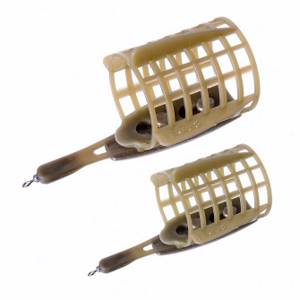
A piece up to 25 cm long is cut from the pipe. Both sides are sealed with plugs, one of which is removable. Holes are made on the surface of the material. A rope is attached to the removable plug.- To prevent the removable plug from opening under water, attach a small lock or latch to it.
- At the other end of the tube, where there is a “tightly” installed plug, weights are secured.
This trick will not only help attract fish, but will also keep it under the boat for a long time.
Tackle
Fishing rod

The main equipment for fishing is a fishing rod. You need to select its size, shape and other parameters based on the place and conditions where you will be fishing. If fishing takes place in the shallows, it is recommended to use a small rod that is suitable for reelless fishing.
And if you are fishing for large fish, then the rod should be as strong as possible, and for pike fishing you will need a long rod that has a sensitive nod. The handle of the fishing rod must be buoyant so that the rod does not sink to the bottom, and must be made of materials that are suitable for use at low temperatures.
To choose a fishing rod you need to know some criteria by which they are divided.
Dimensions:
- Small;
- Average;
- Big ones.
For coil type:
- There is no friction;
- Friction is present;
- Reel with ratchet;
- A rod without a reel.
- Reel with closed spool;
- Open spool reel.
For the type of fastening of the fishing line to the whip:
- The fishing line is attached to the nod, the float through the cambric;
- Through the rings.
Reel, reel
There are many different versions about fishing rods that have a reel or reel. Which one is better? Still, such disputes will not fade away, since many characteristics of fishing rods depend only on the preferences of the angler.
But still, for deep fishing it is better to use a rod with a reel, and at a time when the snow is already wet, the reel may malfunction. So it’s better to always have different types of gear and accessories with you in reserve.
fishing line
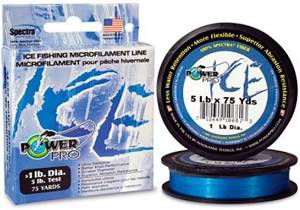
A certain amount of spare line should always be carried with you when ice fishing. The weather changes frequently and fish can react differently to the line. Therefore, it is necessary to have fishing line of different thicknesses with you in order to make a replacement if necessary.
Whip
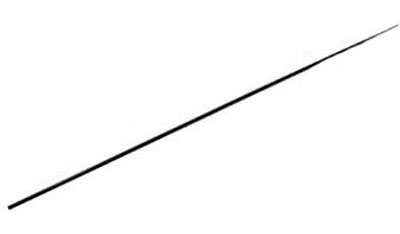
This gear is needed to provide shock absorption when hooking fish. It must be chosen taking into account the fishing location, since the length of the whip varies from 120-180 cm.
Nod

Used to signal a bite and as a tool to control the game of the jig. The nod should be quite elastic, not crack, not break from blows and not sway in the wind. The number of such accessories should be exactly the same as the types of jigs you have in stock.
Fastener for changing the attachment
Every angler is faced with quickly replacing the necessary bait . To ensure that the process of replacing gear does not create difficulties, a special mini-fastener was invented. Of course, you can buy it in a specialized store, but this is a waste of money, because the product can be easily made with your own hands using the following technology:
- The material from which the fastener will be made is a metal stapler from a stapler. Nippers, pliers and tweezers are also prepared. Use pliers to create a paper clip shape from the staple. The protruding edges of the structure are removed with pliers.
- Next, we take cambrics, but those that will be put on the fishing line without much effort. A piece of cambric is strung on a fishing line and secured with a knot.
- The bait is attached to the other edge of the fastener, and to secure it, the cambric should be pulled to the limit.
Fishing clothing
Jacket
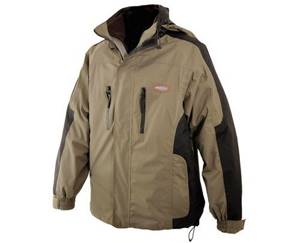
It should be made of fabric that does not get wet, but still breathes. It is advisable to immediately purchase a suit made of waterproof fabric and a warm lining, but if this is not possible, then you can buy each element separately. Important:
The fabric should not get wet, but still breathe and provide warmth. You should give preference to a jacket with a high collar, which protects from the wind and also buttons above the chin to protect against throat infections. It is better to wear such a jacket than to use a scarf. There should be straps at the bottom of the jacket so that the jacket can be tightened to protect against wind from below.
Trousers
Must have straps or a zipper so that their rise reaches half of the back. This will be an excellent protection from wind and cold. It will also be necessary to sew cuffs to them so that they do not ride up during the transition.
Gloves
They should have slots for fingers to make it comfortable to work with baits.
Adviсe

- Pay special attention to the color of clothing. Use bright colors to stand out on the ice. This will help you in case of danger.
- If you are caught in severe frost, add sunflower oil to the hole. This will prevent the water from freezing and will also keep the fish interested.
- After fishing, place the fish immediately in the storage container, without leaving it on ice, otherwise you may end up with the fish freezing.
- If you use glasses while fishing, rub the insides of them with dry soap before going out, which will help prevent fogging.
Lifehacks for fishing:
choosing a place to bite in summer
It should be remembered that in the heat the fish will go to depth. The fish will hide from direct sunlight, so they will start biting near coastal trees and bushes. In summer, the fish bite well early in the morning and late in the evening, when it is not too hot. In the evening, fish can be found closer to the shallows, where the water cools quickly and is saturated with oxygen. During the day, the fish will bite sluggishly; you should look for it in holes and shade from bushes and trees.
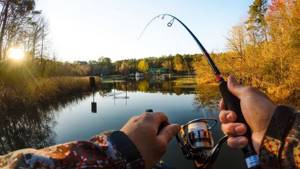
choosing a place to bite in winter
At the beginning of winter, when the first ice has just formed, you should look for fish near the reeds and other vegetation. There is more oxygen and food for fish. In severe weather, the fish hides at depth, in places where there is a reverse current. If you can see a body of water through the ice, look for areas with air bubbles and frozen vegetation. Pay attention to other people's holes. If there are a lot of them, then the previous fishermen probably fished well and the place is profitable.
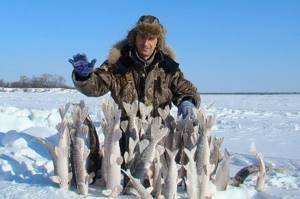
DIY ear in nature
- Place tripods over the wood and build a fire.
- Fill the cauldron with water and put it on fire.
- Peel and cut the potatoes and place in water.
- After 15 minutes, throw in the peeled and sliced carrots.
- After carrots, add millet.
- Peel the onion, cut crosswise, and add to the ear.
- Salt the dish.
- Throw the fish, cleaned and cut into 5 cm pieces, into the fish soup.
- After 15 minutes, pour a glass of vodka into your ear, which will destroy the smell of mud. The alcohol will evaporate during cooking.
- Add bay leaf and spices. At the end, taste for salt, as the fish may absorb some of the salt.
- If desired, at the end of cooking, you can dip a firebrand into the ear to give the dish a “smoky” aroma.

Reviews
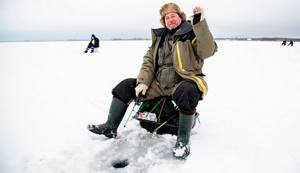
“Thank you for the article, based on your advice I decided on the choice of gear. I was pleased with the fishing." Grade:
Artem
“I agree about thin line, but be sure to consider the ratio of your line to the size of the fish.” Grade:
Nikita
“I always wrapped myself in a scarf and never thought about a jacket with a long collar. Now I’ve changed my wardrobe, after the first fishing there were only good impressions, good bite, comfortable clothes.” Grade:
Vladimir
